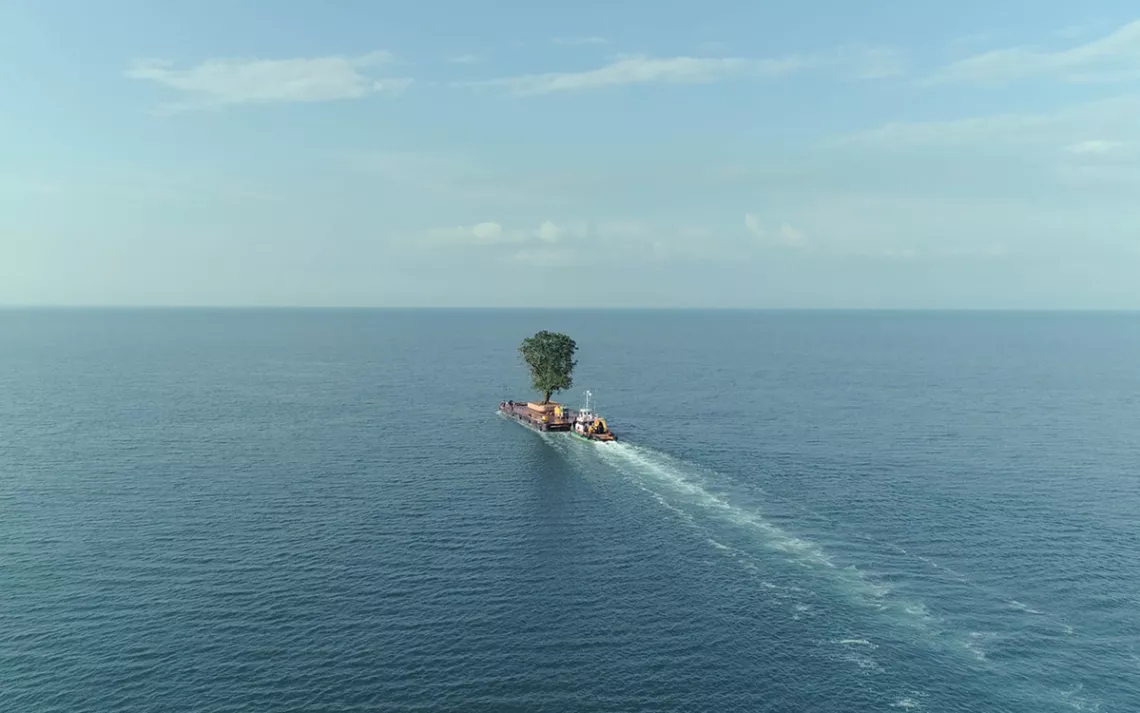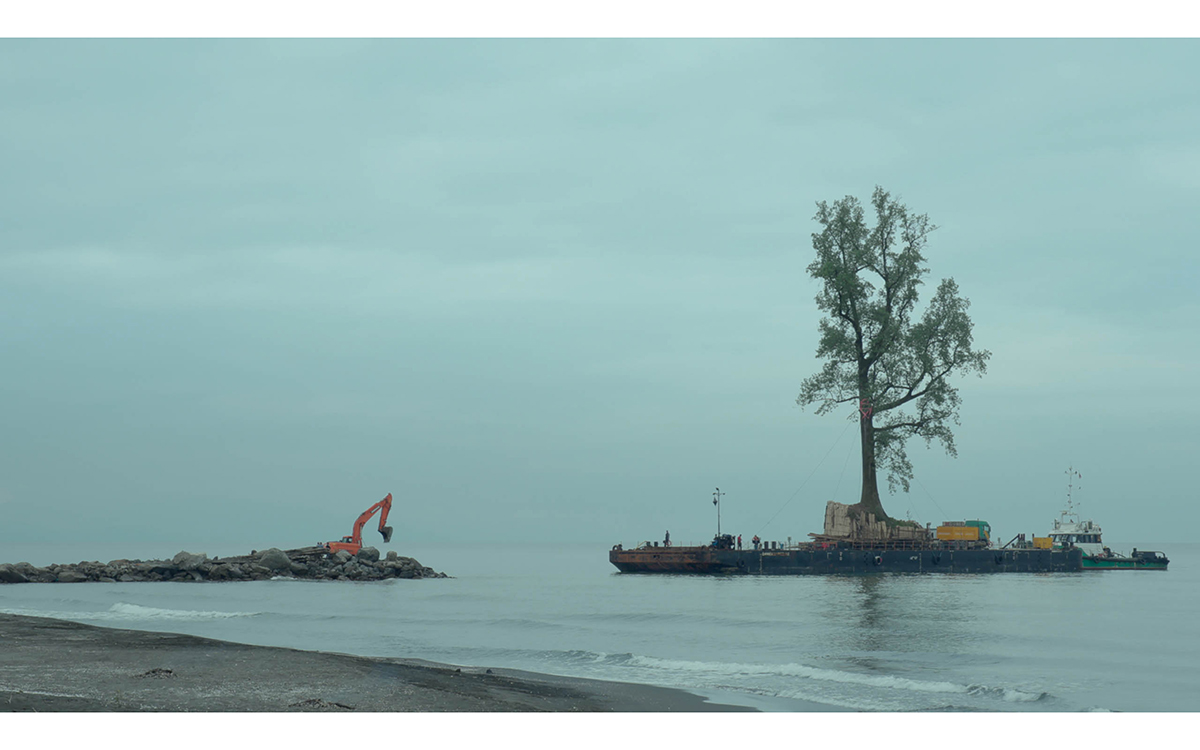Rich Man, Big Tree
Taming the Garden is a fable for our era of vast inequity

The film Taming the Garden begins with a work crew digging a moat-like channel around a massive, fairytale-like tree. As the moat gets deeper, the tree begins to look like the topper on an enormous dirt cake.
The crew rams pipes into the soil beneath the tree’s roots, forming—to continue the metaphor—the cake stand that will support this whole mystifying exercise. From here, the tree will be lifted out of the ground, rolled slowly down a road that has been freshly reconstructed to assist the process, placed on a barge, and floated to a rich man’s glass mansion overlooking the Black Sea.
“My granny and grandpa planted this tree,” says an old man sitting nearby. “Careful they don’t take you with your tree,” someone yells. “This is my first cigarette in 30 years,” says the old man to the camera. At the base of the tree, another man is curled up, sleeping between the roots.
Taming the Garden, which premiered at the Sundance Film Festival earlier this year and is screening again at the DC Environmental Film Festival, began in 2016 after Salomé Jashi, a Georgian journalist-turned-filmmaker, saw photos of a 130-foot-tall tulip tree floating on a barge in the Black Sea. The rare, 135-year-old tree's journey did not go well. Just moving the barge bearing 650 tons of dirt and tree proved to be a challenge, especially given the Black Sea’s shallow coastline. The barge ran aground, and eventually the moving crew built a road (and then a second one after the first collapsed) in order to get the tree to its final destination. Along the way, the tulip tree’s journey became a meme, set to a sentimental Georgian rock ballad.
A month earlier, protesters had tried, unsuccessfully, to block the tree’s removal from the village of Tsikhisdziri in west Georgia. The local government of Adjara had sold the right to remove it, along with two swamp cypresses, for 6,200 laris (about $2,700).
The tree’s buyer was Bidzina Ivanishvili, Georgia's billionaire former prime minister and currently the 349th richest person in the world. (He’s also a fixture in the Panama Papers.) “I purchased the tree legally,” he told AFP. “Giant trees are my hobby. I am developing a park where I think it is appropriate.”
Indeed, the tulip tree was just one of 200 enormous trees that were uprooted for Ivanishvili’s arboretum. For the next two years, Jashi followed and filmed the process of moving some of the others.
In the film, Ivanishvili is never seen and rarely mentioned. The usual details that journalists can’t help but drop about Ivanishvili—his collection of zebras, penguins, lemurs, and a very shy kangaroo; his penchant for donating large sums of money to Georgian cultural institutions with no advance warning, his bodybuilder son with dreams of rap stardom, the Picasso he bought by having a relative appear at the auction and never lower the auction paddle—go unmentioned. (In an essay about the documentary’s production, Jashi writes that many locals were reluctant to appear on camera, out of fear of even appearing to criticize the most powerful man in the country.) Nobody bothers explaining who he is, because everyone already knows. “When he has all the trees,” one villager says, “maybe he’ll go after the birds next!”
The tree in Jashi’s film travels at night—whether out of concern for traffic or just because the movers are in a hurry is never said. Villagers come out of their homes, wrapped in blankets, to watch the tree trundle by on its way to the ocean. By now, it looks very much the worse for wear. The moving crew has sawed off many of its branches so that it can travel down the road unimpeded, but even then, the tree scrapes and catches against the other, younger, less desirable trees lining the street. Attendants with chainsaws accompany the tree down the highway, cutting down any trees lining the road that impede the journey.
“It looks so beautiful in the night; it’s like a fairytale,” says one villager.
“He knows himself that it won’t survive there, but he’s taking it deliberately,” says another.
“This one is so magnificent, you probably got used to it looking at it every day,” a third adds. “It’s become so ugly.”
“How beautiful it was. The beauty of our district. Many generations grew up under it. And so many played under it! And this is how it ends!” says a woman staring mournfully into her cellphone. “It’s all gone now.”

Courtesy of Salomé Jashi | Sundance Institute
Taming the Garden is a visually striking movie—like watching a Flemish painting in slow motion. And it’s also striking for how much Jashi leaves out. In an interview following the film’s premiere at Sundance, Jashi talked about traveling all the way to Zanzibar to film baobab trees being uprooted and moved, and shared that out of the 200 trees moved, three have died since. Neither of these details make it into the film. Even the destination of the trees—Ivanishvili’s Central Park–like estate dotted with Henry Moore sculptures, flamingos, a bamboo grove, many, many black-clad security guards, and perfect green lawns eternally groomed by Toro ride-a-mowers—is only shown briefly. The branches of the trees are anchored to the ground by a crisscrossing network of guy wires—probably to keep them from falling over but creating the impression that otherwise, they might run away in the night.
At its core, Taming the Garden is a fable of extreme wealth. “When you have the power, you can do anything,” Jashi said at Sundance. “This desire has no borders.” Since 1987, the number of billionaires worldwide has risen from 140 to 2,095. In the United States, where inequality has continued to widen since the early 1980s, the top 100 wealthiest people together own about 20 percent more land than they did a decade ago—2 percent of North America’s landmass, or an area about the size of Florida. A century-old tree floating in the ocean is a striking illustration of that power, but it raises the question, How else is that power shaping our world?
 The Magazine of The Sierra Club
The Magazine of The Sierra Club



